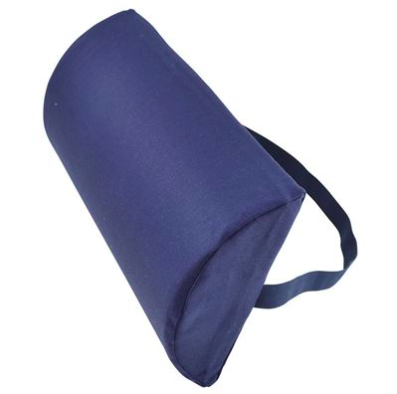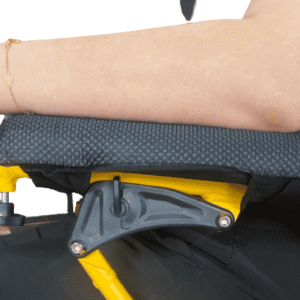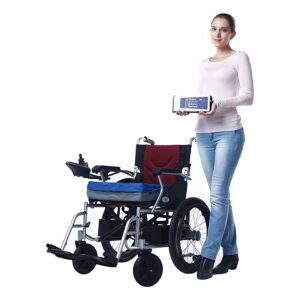Description
BRAND NEW SUPPORT LUMBAR ROLL CUSHION AND SUPPORT
Our new Lumbar roll D pillow provides structural support to your lumbar spine and allows you to sit comfortably.
The Lumbar D-Roll pillow Support is an excellent tool for wheelchair users to minimise stress on the spine and reduce lower back pain in any sitting position or while lying down. It will ensure you maintain the optimal spinal position for your lower back whilst sitting and is a must for patients who suffer from lower back pain (particularly whilst sitting).
The rounded part of the d-shape fits comfortably into the lower back, and the flat part of the cushion sits flush against a chair or bed. The strap ensures the support remains in the correct position as it hugs the chair or seat.
Lightweight, portable, and easy to use, the D-Roll Lumbar Support is ideal for preventing and managing lower back pain – whether in the car, office, wheelchair, or home.
The D-Roll Lumbar Support is made of high-density foam and has a removable and washable cover.
Frequently Asked Questions about the Lumbar Roll Support Cushion

The Lumbar D-Roll pillow Support is an excellent tool for wheelchair users to minimise stress on the spine and reduce lower back pain in any sitting position or while lying down.
1- How does the Lumbar Roll Cushion help to maintain the natural curvature of your spine?
The spine's normal curvature has an S-shaped curve when viewed from the side. This allows your weight to be evenly distributed and flexibility of movement.
Normal Spine Curvatures in Side View:
- The "Neck Curve" is called the cervical spine, and it curves slightly inward and is also described as a backward "C-shape" or lordotic curve.
- The "Rib Curve" is called the thoracic spine and curves outward, forming a "C-shape" or a kyphotic curve.
- The "Lower Back Curve" is called the lumbar spine and curves inward and, like the cervical spine, has a lordotic or backward "C-shape".

Curvatures of the spine
When the curves of the spine move out of line in different ways and lack their usual turn, it may lead to pain, deformity and neurologic dysfunction. Some abnormal curves are asymptomatic, while others require treatment.
Scoliosis is an abnormal spine curve where vertebrae are located laterally from the midline forming an "S-shape" when looking at someone from the back.
Prolonged sitting can cause the lordotic curve of the lower back to decrease abnormally and cause further complications. The Lumbar Roll Support Cushion provides support and helps to maintain the natural curvature of the lower back.
2- What are the symptoms and signs of lumbar lordosis?
Symptoms and signs of lumbar lordosis (lordotic spine) are not limited to but may include...
- The appearance of being "swayback" or abnormal posture with an arched lower spine
- Buttocks appearing more pronounced
- Having a large gap or arch between the lower back and a flat surface when lying on your back
- Discomfort and back pain
- Difficulty in moving in specific directions
Some people may develop nerve problems (numbness/tingling of lower extremities, poor bladder control, weakness, electric-like pains).

Ideal spinal posture in wheelchair users
3- What are the common causes of lumbar lordosis in children, adults, and while pregnant?
Common causes of lumbar lordosis
- Discitis
- Obesity
- Kyphosis
- Osteoporosis
- Spondylolisthesis
Causes of lumbar lordosis in children
- Bad posture
- Previous spine surgery
- Pelvis or hip injury
- Congenital
- Genetics
- Dwarfism
- Other spine disorders
Causes lumbar lordosis in women during pregnancy
Lumbar lordosis in pregnancy is thought to be due to the spine adjusting itself to the new centre of gravity of the pregnant lady as the pregnancy weight gain causes abdominal enlargement. This can be reversed after birth.
4- Common Symptoms and Signs of Kyphosis
The most common symptoms for people with abnormal kyphosis are the appearance of poor posture with a hump appearance of the upper back or a flat lower back or neck.
Symptoms may include:
- Back pain
- Muscle fatigue
- Stiffness in the back
Most often, these symptoms remain constant and do not become progressively worse with time.

Abnormal Curvature of the Spine
5- What procedures and tests diagnose lumbar lordosis?
Procedures and tests for lumbar lordosis are the histories and physical exams used to diagnose lordosis. Other studies, such as X-rays and CT of the spine, can also aid in diagnosing.
6- Can you prevent lumbar lordosis?
Some people may prevent lumbar lordosis by preventing specific causes such as obesity, poor posture and trauma. Other causes such as congenital or genetic lordosis are not preventable.
7- What is the Lumbar Roll Cushion used for?
A lumbar roll is designed to sit in the inward curve of your lower back to improve your sitting posture. This can prevent and provide relief from back pain.
8- Who should use the Lumbar Roll?
Anyone can use the Lumbar D-Roll Supportive Cushion! Lumbar support is beneficial for:
- Office workers that sit down on non-ergonomic chairs all day can benefit from using the Lumbar D roll to maintain the curvature of their lumbar spine and prevent aches, pains and overcompensation of their front hip muscles
- Pregnant ladies with extra pressure on their pelvic bones, lower back muscles and joints can also benefit from using the Lumbar D-Roll to maintain the curvature of their lumbar spine as the natural lordosis curve increases during pregnancy to move their centre of gravity, compensating for their growing belly
- Wheelchair users - most wheelchairs are not built ergonomically. Sitting on a wheelchair for long periods without lumbar support can alter the shape of your lower back curvature, causing a "sway-back" position. The Lumbar Roll Support Cushion can be used with electric wheelchairs, manual wheelchairs, and mobility scooters!
- Regular Drivers - most cars, especially older models, do not have the appropriate support for your lumbar spine; the Lumbar Roll can provide additional lower back support and make you feel more comfortable driving long distances.

Sufficient lumbar lordosis is essential to maintain whilst driving
Contact us today to learn more about how you can use your
NDIS funding for the Lumbar D roll for Wheelchair Users!
Can't find what you are looking for?
Call us, and our sales assistants can organise a customised cushion for you!
Now offers a 10% Seniors Card Discount on all our products!













